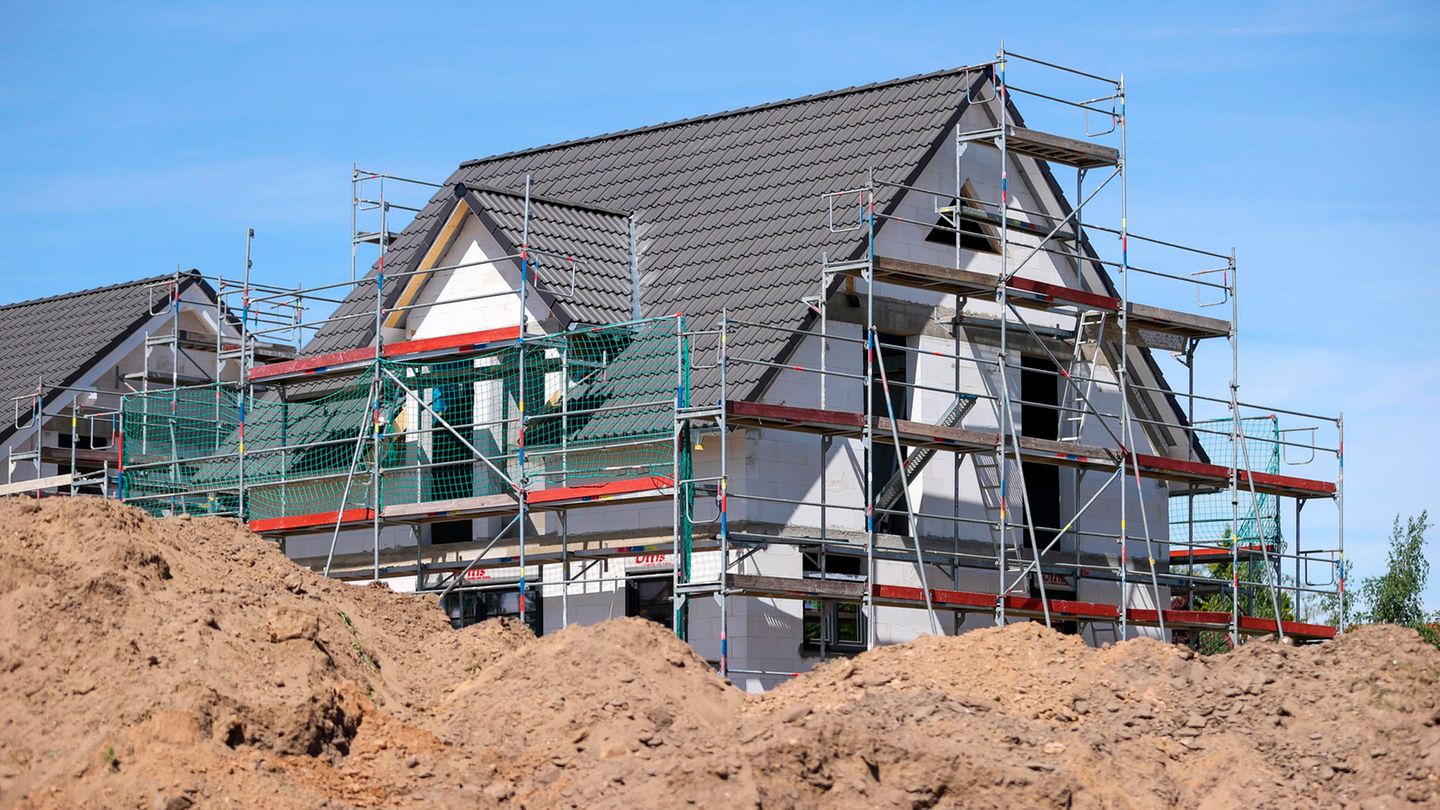Housing construction is in crisis, which is why desperate seekers are increasingly moving out of the cities. But is this the great new country lust?
Only one thing is currently growing in German housing construction: the pile of canceled orders and canceled new construction projects. The construction industry already has more stopped projects than ever since 1992: According to surveys by the Ifo Institute, more than one in five construction companies have canceled new construction projects. Almost half of the companies in the industry complain about lost orders. And almost twelve percent already admit that they have problems with financing. The first high-profile bankruptcies of property developers have already occurred. But now there is a threat of a major construction crisis – and this will have noticeable effects on both large cities and rural regions.
Because if the construction of new apartments is stalling everywhere, that means, first of all, that there is a lack of more living space in the centers than there already is. This will also intensify the effect that population researchers have been observing increasingly for the last two to three years: more people are moving out of the city centers – and more and more of them are pushing into the outskirts of the big cities, but also further and further out into more rural areas.
A current study by the Berlin Institute for Population and the Wüstenrotstiftung puts it this way: “People are moving to rural areas again. Just over ten years ago, people were mainly moving to large cities with more than 100,000 inhabitants. More people were moving from rural communities and small towns away than away. Today the picture is different. Many villages and small towns are now also among the migration winners.”
There are two exciting questions that are affecting the housing market: Are we dealing with a new desire for the countryside that will continue and could make life in rural areas more attractive again? And will the urban housing markets relax as a result – even though there are so many apartments missing and construction is stalling?
Looking across the country as a whole, there is currently no real housing shortage in the Federal Republic, the real estate economists at the IW economic research institute note – apartments are just incorrectly distributed. While many houses and buildings in rural areas and shrinking regions are empty, construction has not been possible in the metropolises for years as quickly as the population there is growing. So isn’t it so bad that there’s no more construction going on in the cities because everyone will be moving out to the countryside soon anyway?
The thesis of the new landlust
Many media outlets and the current study like to talk about a “new desire for the countryside”. But you have to differentiate here: It is true that in recent years more people, mainly young and middle-aged families, have been moving out of the direct centers of big cities. But where are they going? The vast majority of them go to the immediate suburbs of these cities, i.e. to neighboring communities. Some also go further afield, but are closely connected to the respective metropolis by transport routes. Very few people still venture into the countryside.
In addition, small towns and remote villages are now gathering a few new residents, so their “migration balance” is positive, as it is called in technical language. “Internal migration in rural areas was positive for the first time in 2021,” says the IW – because more people are moving there than moving away. The Berlin study focuses very much on this. But overall, most of these rural places are still shrinking demographically because more residents are dying than moving.
In the big cities, on the other hand, it is exactly the other way around: There has recently even been a slight surplus of births there and also positive migration balances because the number of foreign immigrants far exceeds the number of those who are already resident.
Overall, according to the figures from the Federal Statistical Office, the local metropolitan regions grew by around 2.5 million people from 2012 to 2021, which corresponds to a population increase of 4.4 percent in the metropolises (including their surrounding areas). In the rest of the republic (i.e. in more rural areas) the population also grew, but only by a manageable 0.9 percent. Basically, there are now more people living everywhere because the total population has increased so much that demography researchers had previously not thought possible.
The population in the cities is still growing
But one cannot conclude from this that more people are now moving to the countryside than to the cities. A proud 71 percent of the population lives in large cities, that’s 59 million German citizens, more than ever before. And at least 40 percent of them live in the middle of the centers. Incidentally, there are no more recent figures than those from 2021; the Berlin study also only referred to this period, which was also heavily influenced by the effects of the corona pandemic. It could therefore theoretically be that the move to the countryside only occurred in the two years 2020 and 2021, i.e. only in the last two years recorded by the statistics so far. It remains to be seen whether a strong migration to more rural areas will be observed even after the end of the lockdowns and whether a trend can be derived from this.
The decisive factor is probably the reasons why people move from the centers to the suburbs and surrounding communities. Are there more push or pull effects that are causing people to migrate from the big cities? So are they being pushed out of the centers – or are they being attracted to more rural life? So far, some studies have tried to answer this through observations and surveys, including those from the IW. And one may doubt whether the “new country lust” really exists.
The most likely explanation is that until the start of the corona pandemic, the hike was mainly price-related. Because many young families no longer wanted or could cope with the rising real estate prices (for purchase and rent) in the big cities, they looked for new living space in the neighboring areas. First in the directly adjacent areas and only then – by necessity, so to speak – in the more remote areas of the metropolitan regions. There they often afforded larger apartments, usually at cheaper prices. This is a classic push effect.
People tend to stay in smaller metropolises
Further evidence of the price push factor is the fact that the highest migration was found in the top 7 major cities – these are also where the highest real estate prices are found. According to the IW, emigration is already much lower in the second tier of metropolises. Where real estate was more affordable, people migrated significantly less. The respondents to the Berlin study also confirmed this: When asked what drove them to the country, most cited the high housing prices in the cities. Only then did the answer come: “The children should grow up in the country.”
Since the corona pandemic, the possibility of working from home has also made life in the country more attractive. However, study participants often complain about poor internet connections in surveys. On the one hand, this makes it more difficult to practice your job, and on the other hand, it also makes social contacts more difficult.
The answers to the question of what makes village places attractive are also telling. The Berlin study asked this of those who had recently moved out and who were actually moving to the country (and not just to the suburbs). The most common feedback: a motorway connection and a good rail connection, as well as childcare options for children and a wide range of housing options. Not exactly typical features of country life. In addition, a number of new rural residents said that they still had to “learn” to integrate into village structures such as clubs and neighbors. In any case, a shrinking number of meeting places such as pubs, restaurants and local grocery stores, which can be derived from the statistics, does not make it easy for them.
It’s more like big city frustration
So you can put it more like this: There is no new desire for the country, but rather city frustration, which is forcing people to the outskirts of the city and the surrounding communities. At least that was the case in the late years of the real estate boom. And because prices have fallen since then, but financing interest rates have risen enormously, housing in inner-city locations has not become more affordable despite the economic downturn in construction. The crowding out effect is therefore likely to continue.
And worse still: the current construction crisis, which is ensuring that new construction will stall or at least sputter for years, will soon mean that living space in cities will become even more scarce because the influx from abroad continues – and with it more expensive again. So the metropolitan markets will not relax. But neither is the situation in the surrounding area.
The IW researchers emphasize that housing construction alone is the “central lever for reducing tensions”. Since many large cities are currently not developing new residential areas either in the interior or in the outskirts, the spillover effect into the surrounding area will continue. Along with the negative consequences he has there. This means that more area is sealed because buildings are built less densely than in metropolitan areas. The transport infrastructure also needs to grow. For the time being, construction is also taking place where there is no public transport yet because the prices there are still cheap, so traffic pressure is also increasing. After all, those who live in rural areas are more dependent on cars and usually commute longer distances to work, even if they work from home.
Think about solutions
It’s not all that positive. Although in many shrinking places it would of course be desirable for village life to continue there. It could help if politicians at least prevented the collapse of housing construction – by providing bridging loans for construction projects that have already been planned or at least discounted KfW loans that are repaid. The states could inject funding that they have already collected from the industry and every home buyer through the sharp increase in real estate transfer taxes.
Basically, it is urgently necessary to be able to build more new apartments where most people really want to live – i.e. in metropolitan areas and as close to the city as possible. In addition, large cities urgently need more small apartments because 80 percent of households there are one or two person households. However, what is currently being built is mainly large units with four or more rooms, which property developers can no longer sell. If there were more small apartments at affordable prices, more larger apartments would become available again because widows, unpartnered people or parents with fledgling children could then move again.
In the more rural regions, however, local politicians should ensure that they reactivate or repurpose existing buildings. By not simply designating new development areas, but by turning vacant properties into attractive living space again and creating smaller residential units for older people and trainees. Because not everyone there wants or needs a single-family home or a family apartment.
In general, cities and rural communities have to work to ensure that people enjoy living there again: where they also have their work.
Source: Stern




